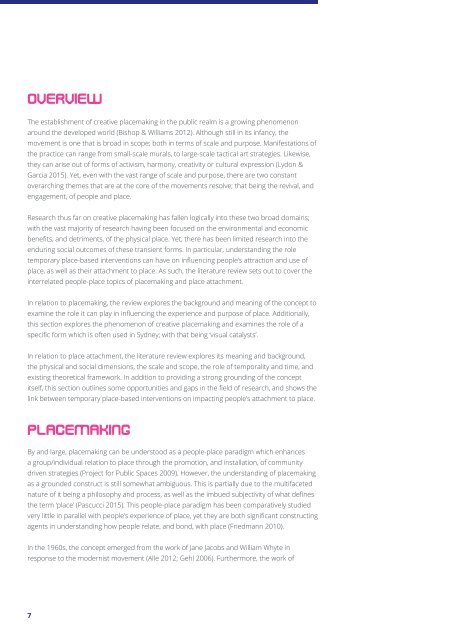Exploring the Role of 'Visual Catalysts' on Influencing People's Attraction and Use of Place
Undergraduate Thesis // Keegan Lovell // Bachelor of Landscape Architecure // UNSW 2016
Undergraduate Thesis // Keegan Lovell // Bachelor of Landscape Architecure // UNSW 2016
You also want an ePaper? Increase the reach of your titles
YUMPU automatically turns print PDFs into web optimized ePapers that Google loves.
OVERVIEW<br />
The establishment <str<strong>on</strong>g>of</str<strong>on</strong>g> creative placemaking in <str<strong>on</strong>g>the</str<strong>on</strong>g> public realm is a growing phenomen<strong>on</strong><br />
around <str<strong>on</strong>g>the</str<strong>on</strong>g> developed world (Bishop & Williams 2012). Although still in its infancy, <str<strong>on</strong>g>the</str<strong>on</strong>g><br />
movement is <strong>on</strong>e that is broad in scope; both in terms <str<strong>on</strong>g>of</str<strong>on</strong>g> scale <strong>and</strong> purpose. Manifestati<strong>on</strong>s <str<strong>on</strong>g>of</str<strong>on</strong>g><br />
<str<strong>on</strong>g>the</str<strong>on</strong>g> practice can range from small-scale murals, to large-scale tactical art strategies. Likewise,<br />
<str<strong>on</strong>g>the</str<strong>on</strong>g>y can arise out <str<strong>on</strong>g>of</str<strong>on</strong>g> forms <str<strong>on</strong>g>of</str<strong>on</strong>g> activism, harm<strong>on</strong>y, creativity or cultural expressi<strong>on</strong> (Lyd<strong>on</strong> &<br />
Garcia 2015). Yet, even with <str<strong>on</strong>g>the</str<strong>on</strong>g> vast range <str<strong>on</strong>g>of</str<strong>on</strong>g> scale <strong>and</strong> purpose, <str<strong>on</strong>g>the</str<strong>on</strong>g>re are two c<strong>on</strong>stant<br />
overarching <str<strong>on</strong>g>the</str<strong>on</strong>g>mes that are at <str<strong>on</strong>g>the</str<strong>on</strong>g> core <str<strong>on</strong>g>of</str<strong>on</strong>g> <str<strong>on</strong>g>the</str<strong>on</strong>g> movements resolve; that being <str<strong>on</strong>g>the</str<strong>on</strong>g> revival, <strong>and</strong><br />
engagement, <str<strong>on</strong>g>of</str<strong>on</strong>g> people <strong>and</strong> place.<br />
Research thus far <strong>on</strong> creative placemaking has fallen logically into <str<strong>on</strong>g>the</str<strong>on</strong>g>se two broad domains;<br />
with <str<strong>on</strong>g>the</str<strong>on</strong>g> vast majority <str<strong>on</strong>g>of</str<strong>on</strong>g> research having been focused <strong>on</strong> <str<strong>on</strong>g>the</str<strong>on</strong>g> envir<strong>on</strong>mental <strong>and</strong> ec<strong>on</strong>omic<br />
benefits, <strong>and</strong> detriments, <str<strong>on</strong>g>of</str<strong>on</strong>g> <str<strong>on</strong>g>the</str<strong>on</strong>g> physical place. Yet, <str<strong>on</strong>g>the</str<strong>on</strong>g>re has been limited research into <str<strong>on</strong>g>the</str<strong>on</strong>g><br />
enduring social outcomes <str<strong>on</strong>g>of</str<strong>on</strong>g> <str<strong>on</strong>g>the</str<strong>on</strong>g>se transient forms. In particular, underst<strong>and</strong>ing <str<strong>on</strong>g>the</str<strong>on</strong>g> role<br />
temporary place-based interventi<strong>on</strong>s can have <strong>on</strong> influencing people’s attracti<strong>on</strong> <strong>and</strong> use <str<strong>on</strong>g>of</str<strong>on</strong>g><br />
place, as well as <str<strong>on</strong>g>the</str<strong>on</strong>g>ir attachment to place. As such, <str<strong>on</strong>g>the</str<strong>on</strong>g> literature review sets out to cover <str<strong>on</strong>g>the</str<strong>on</strong>g><br />
interrelated people-place topics <str<strong>on</strong>g>of</str<strong>on</strong>g> placemaking <strong>and</strong> place attachment.<br />
In relati<strong>on</strong> to placemaking, <str<strong>on</strong>g>the</str<strong>on</strong>g> review explores <str<strong>on</strong>g>the</str<strong>on</strong>g> background <strong>and</strong> meaning <str<strong>on</strong>g>of</str<strong>on</strong>g> <str<strong>on</strong>g>the</str<strong>on</strong>g> c<strong>on</strong>cept to<br />
examine <str<strong>on</strong>g>the</str<strong>on</strong>g> role it can play in influencing <str<strong>on</strong>g>the</str<strong>on</strong>g> experience <strong>and</strong> purpose <str<strong>on</strong>g>of</str<strong>on</strong>g> place. Additi<strong>on</strong>ally,<br />
this secti<strong>on</strong> explores <str<strong>on</strong>g>the</str<strong>on</strong>g> phenomen<strong>on</strong> <str<strong>on</strong>g>of</str<strong>on</strong>g> creative placemaking <strong>and</strong> examines <str<strong>on</strong>g>the</str<strong>on</strong>g> role <str<strong>on</strong>g>of</str<strong>on</strong>g> a<br />
specific form which is <str<strong>on</strong>g>of</str<strong>on</strong>g>ten used in Sydney; with that being ‘visual catalysts’.<br />
In relati<strong>on</strong> to place attachment, <str<strong>on</strong>g>the</str<strong>on</strong>g> literature review explores its meaning <strong>and</strong> background,<br />
<str<strong>on</strong>g>the</str<strong>on</strong>g> physical <strong>and</strong> social dimensi<strong>on</strong>s, <str<strong>on</strong>g>the</str<strong>on</strong>g> scale <strong>and</strong> scope, <str<strong>on</strong>g>the</str<strong>on</strong>g> role <str<strong>on</strong>g>of</str<strong>on</strong>g> temporality <strong>and</strong> time, <strong>and</strong><br />
existing <str<strong>on</strong>g>the</str<strong>on</strong>g>oretical framework. In additi<strong>on</strong> to providing a str<strong>on</strong>g grounding <str<strong>on</strong>g>of</str<strong>on</strong>g> <str<strong>on</strong>g>the</str<strong>on</strong>g> c<strong>on</strong>cept<br />
itself, this secti<strong>on</strong> outlines some opportunities <strong>and</strong> gaps in <str<strong>on</strong>g>the</str<strong>on</strong>g> field <str<strong>on</strong>g>of</str<strong>on</strong>g> research, <strong>and</strong> shows <str<strong>on</strong>g>the</str<strong>on</strong>g><br />
link between temporary place-based interventi<strong>on</strong>s <strong>on</strong> impacting people’s attachment to place.<br />
PLACEMAKING<br />
By <strong>and</strong> large, placemaking can be understood as a people-place paradigm which enhances<br />
a group/individual relati<strong>on</strong> to place through <str<strong>on</strong>g>the</str<strong>on</strong>g> promoti<strong>on</strong>, <strong>and</strong> installati<strong>on</strong>, <str<strong>on</strong>g>of</str<strong>on</strong>g> community<br />
driven strategies (Project for Public Spaces 2009). However, <str<strong>on</strong>g>the</str<strong>on</strong>g> underst<strong>and</strong>ing <str<strong>on</strong>g>of</str<strong>on</strong>g> placemaking<br />
as a grounded c<strong>on</strong>struct is still somewhat ambiguous. This is partially due to <str<strong>on</strong>g>the</str<strong>on</strong>g> multifaceted<br />
nature <str<strong>on</strong>g>of</str<strong>on</strong>g> it being a philosophy <strong>and</strong> process, as well as <str<strong>on</strong>g>the</str<strong>on</strong>g> imbued subjectivity <str<strong>on</strong>g>of</str<strong>on</strong>g> what defines<br />
<str<strong>on</strong>g>the</str<strong>on</strong>g> term ‘place’ (Pascucci 2015). This people-place paradigm has been comparatively studied<br />
very little in parallel with people’s experience <str<strong>on</strong>g>of</str<strong>on</strong>g> place, yet <str<strong>on</strong>g>the</str<strong>on</strong>g>y are both significant c<strong>on</strong>structing<br />
agents in underst<strong>and</strong>ing how people relate, <strong>and</strong> b<strong>on</strong>d, with place (Friedmann 2010).<br />
In <str<strong>on</strong>g>the</str<strong>on</strong>g> 1960s, <str<strong>on</strong>g>the</str<strong>on</strong>g> c<strong>on</strong>cept emerged from <str<strong>on</strong>g>the</str<strong>on</strong>g> work <str<strong>on</strong>g>of</str<strong>on</strong>g> Jane Jacobs <strong>and</strong> William Whyte in<br />
resp<strong>on</strong>se to <str<strong>on</strong>g>the</str<strong>on</strong>g> modernist movement (Alle 2012; Gehl 2006). Fur<str<strong>on</strong>g>the</str<strong>on</strong>g>rmore, <str<strong>on</strong>g>the</str<strong>on</strong>g> work <str<strong>on</strong>g>of</str<strong>on</strong>g><br />
7


